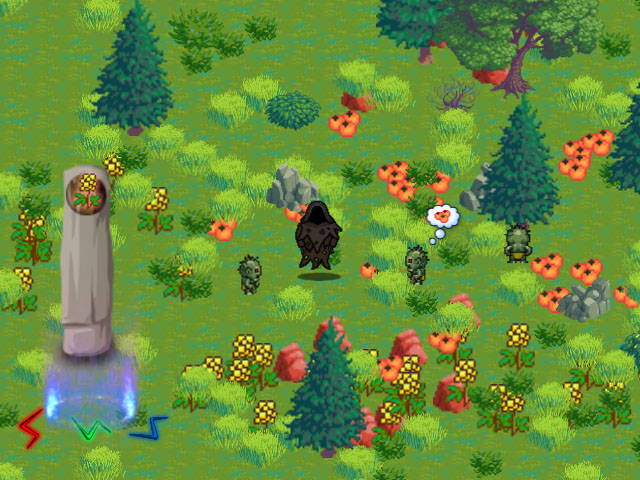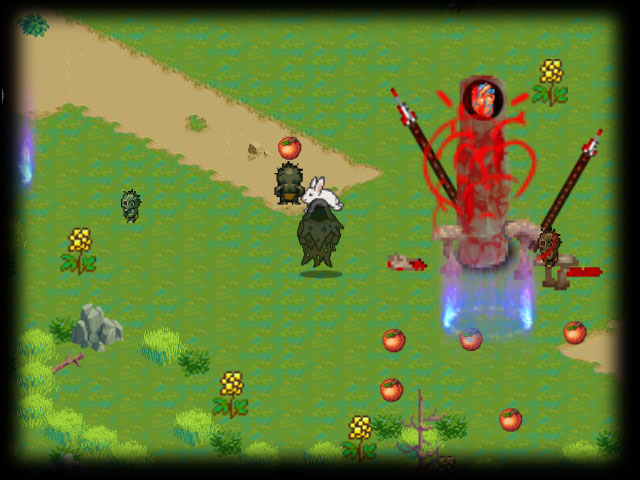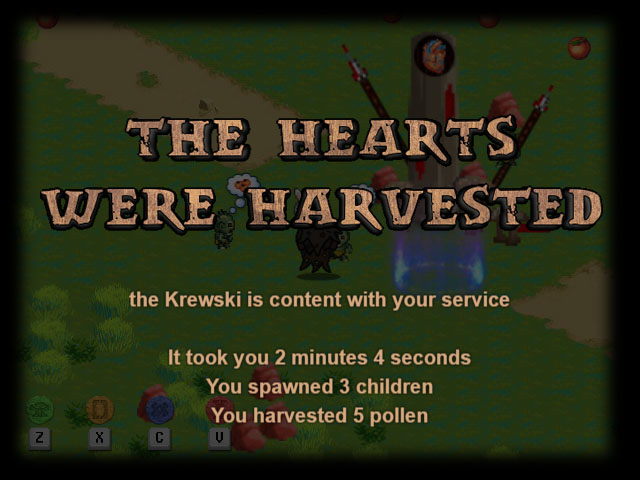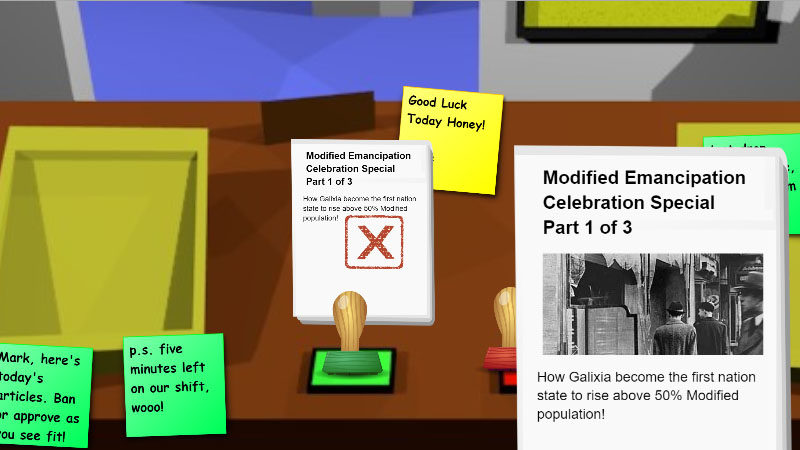What is GATHER?
Gather is a game about leading minions in a foreign land as you learn their language, abilities and harvest sacrifice for the Gods.

You control a Wraith sent to the idyllic land who must learn the rules of the world on his own. Powerless to affect the material realm, you must find arcane words to command and grow your minions, gather various objects and discover their use. The Krewski god demands sacrifice – but of what kind? And how will you appease them?
You can play GATHER right now in your browser! It is my second design experiment released on GameJolt and Newgrounds.
New goals and new marketing
I previously wrote about what inspired the game, but I added a few extra design limitations like only relying on non-verbal communication (via visual information pylons) and letting the player discover the mechanics on their own via trial and error. Which… did not work out that well (as you will see below).
Further, in most of my games the story comes before my gameplay, but in Gather, I started with just the mechanics and no real idea “why.” But I needed a justification and motivation for the player, so after a few brainstorming sessions, the pieces started falling in place.
I also tried a new marketing/publicity approach. Traditionally, I am very formal in my game public image and only show the best. This time, I wanted to start earlier. I made a complete “marketing schedule” outlining which updates (images, posts, etc.) will go up on what day preceding the launch.
Overall, sadly, this seemed to have little impact. Perhaps the idea just wasn’t that enticing, but I only gained 3 followers on GameJolt who never commented on anything. So much for building momentum or gaining feedback.
(However, I am continuing this with my next project HEADLINER, going even further by sharing my full design doc – something I’ve never done before).

What went right
Here’s a few highlights of what people enjoyed. I think I have a knack for this dark-grim atmosphere.
- Dark/Morbid undertones: as with CRAVEN, gamers really enjoyed the slight morbid themes such as killing the bunnies or gathering hearts. I feel more confident using those motifs and testing how far I can push it without turning the player off!
- Art: again echoing my previous game, people really enjoyed the aesthetic Even though it’s mostly free assets made by others, I spent a lot of time researching sprites and tweaking to make them all fit. Glad my efforts were worth it!
- Indirect control and Minion free will: a lot of players remarked they liked that your children had a mind of their own and would not always do what you wanted. I think I pushed it too far into the disobedient category, but a little bit of follower autonomy made the experience more interesting than traditional RTSes.

What went wrong
A lot more than I anticipated! But all part of design experimenting :)
- Confusion and Frustration: The biggest failing, and most valuable lesson. I hoped to evoke a sense of wonder to make the players experiment and learn the world, but ended up confusing and frustrating them instead. They felt aimless. I normally hate sandbox, set-your-own-goals games like Minecraft, No Man’s Sky, or even GTA and Skyrim. Exactly because I feel like I’m just “mucking around” without a purpose, eventually getting bored. I suppose having the same problem with GATHER shows I fundamentally don’t “get” what makes that genre fun.I do wonder what I am “missing” – based on feedback, I think it’s lack of clear explanation and not making the mechanics intrinsically rewarding or fun enough (building stuff in minecraft or using your hook in Just Cause is inherently “awesome”). So instead of engaging the player, making them want to figure it out, it frustrates them into quitting.
- Imbalanced difficulty curve: the beginning of the game has been noted as much more difficult than latter half, before you gather all the words and figure out the mechanics. I think this goes back to lack of explanation and tediousness of the minion control early on.
- Development Time: this game took way longer than I wanted, further accented by its poor reception. I still need to work on getting in the rapid-prototyping mode.
- Isometric + Phaser: I used Rotate’s Isometric Plugin for Phaser. While it’s a nifty little addon, I ran into numerous problems trying to set up my world. For example, one can only depth-sort sprites in the same group, meaning ALL my sprites had to be in the same massive group. Given most of them didn’t need physics bodies (but some did) only further complicated the issue. I had to spend two days just optimizing, which I did not anticipate.
- Interface: The browser and Phaser mouse interface can be problematic – initially it was too easy to accidentally move the mouse outside the game window, ending up selecting a bunch of text below it and scrolling the page down. I had to lock the mouse to the canvas and create a “virtual cursor” to avoid that problem.

Where to go from here?
Clearly, the design experiment failed, at least compared to CRAVEN. But where there is failure, there are many valuable lessons to be learned, so it is a net positive. At least now I know not to sink 2 years into this kind of a project like I did with Karaski ;p
I’d need to go back to the drawing board and rework a lot of mechanics to make it better. The non-verbal communication ended confusing the player, so perhaps a traditional tutorial system would have worked better? Some helpful folks on Newgrounds pointed out a few clever ways I could have made the game clearer, such as placing temporary totems when the “summon minion” command is used to give a visual aid of what is happening.
Building on the idea, I could add more items with various interactions (perhaps planting seeds to grow apple trees? attracting bees to pollinate flowers?) and word combinations for advanced control of your minions. I would not want to take it into the Populus-esque god-like powers (as some players suggested), but perhaps you could learn more and more ways to influence the world as you go along.

How does it compare to my previous experiment?
Overall, this prototype was a bit more self-contained than my previous game, Craven. While Craven felt like a good first level of a longer game, Gather feels more like a simple world that can be iterated and grown. A level structure would definitely work as well, but the way I envisioned the design, it was never meant to be bigger than it was (while in Craven I had plenty of ideas for different stages, enemies or challenges).
Interestingly, the same dark-grim theme arose as in Craven, albeit accidentally. Being inspired by taking care of children in idyllic Switzerland, I wanted it to be more happy and pleasant but… I could not find the right sprites for little happy minion blobs, and I still had to puzzle out who the player is and why they’re collecting hearts. Dark-grim seemed to just fit.
Next Project
I am currently working on the third design experiment, going back to my narrative roots. HEADLINER is a game about curating DigiPaper articles and shaping public opinion in a near-future world of genetically modified embryos. I am being even more open with my design this time, so you can already follow and watch my progress right here on GameJolt!

In the meantime, why not play GATHER right now?